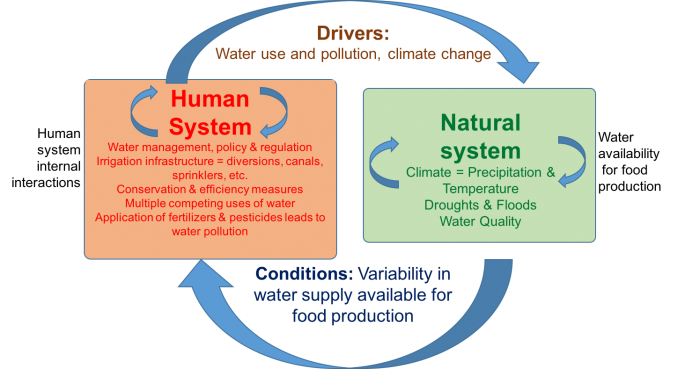Summative Assessment: Kansas Farm Case Study
Water is essential to growing food, and the source of water for food production is either naturally occurring precipitation or irrigation from surface or groundwater. The application of fertilizers and pesticides to crops results in the production of water pollution. We can incorporate water resources into our Coupled Human-Natural System diagram, where the climate of the natural system determines the availability of water for food production. The response in the human system is to develop irrigation systems where necessary and implement conservation and efficiency measures in times of scarcity. Also, the application of fertilizers and pesticides results in water pollution, which impacts the water quality in the natural system.

Human/Natural System Diagram
Human System (Human System Internal Interactions)
- Water management, policy, and regulation
- Irrigation infrastructure = diversions, canals, sprinklers, etc.
- Conservation and efficiency measures
- Multiple competing users of water
- Application of fertilizers and pesticides leads to water pollution
*arrow pointing from human system to natural system: drivers: water use and pollution, climate change*
Natural System (Water availability for food production)
- Climate = precipitation and temperature
- Droughts and floods
- Water quality
*arrow pointing from natural system to human system: conditions: variability in water supply available for food production*
Instructions
In the summative assessment for Module 4, you'll apply what you've learned about coupled human and natural water systems to a particular farming scenario in Pawnee County, Kansas. You'll consider the precipitation in Kansas, the crops you could grow with that precipitation and then look at crop yields for different crops using irrigation. Finally, you'll consider the impact on water resources if you were to shift the types of crops grown and irrigation practices on a farm in Pawnee County, KS. The assignment is explained in the worksheet below.
- Download Module 4 Summative Assessment Worksheet:
- Located on next page
- Download the Excel spreadsheet for calculations for Module 4 Summative Assessment
- Located on next page
- Submitting your Assignment
- You will not be submitting your assignment, you will be using the worksheets as a guide for completing the Summative quiz.
